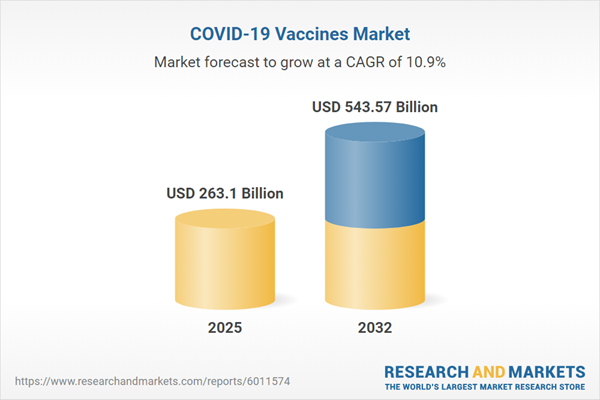Speak directly to the analyst to clarify any post sales queries you may have.
The global COVID-19 vaccines market is undergoing rapid transformation, challenging senior leaders to adapt to shifting technologies, regulatory requirements, and distribution patterns. This evolving environment prioritizes proactive planning, flexible operations, and resilient supply chains to sustain competitive positioning and reduce risk for pharmaceutical and healthcare organizations.
Market Snapshot: COVID-19 Vaccines Market Size and Growth Trajectory
The COVID-19 vaccines market is set for substantial expansion between 2024 and 2032, supported by ongoing investments in scientific research, innovative vaccine development platforms, and more efficient production methodologies. As organizations intensify efforts in digital transformation and build agile supply chains, they are achieving improved operational resilience and a broader international footprint. Strategic collaborations and the implementation of leading immunization approaches are actively increasing vaccine accessibility for various populations. Market leaders focus on enhancing logistical capabilities and driving continual advancements in vaccine technology, reflecting a collective commitment to both adaptability and global reach in a rapidly evolving sector.
Scope & Segmentation of the COVID-19 Vaccines Market
This report provides senior decision-makers with a granular segmentation of the COVID-19 vaccines market, enabling focused strategy development, streamlined internal coordination, and precise targeting of growth areas. Each segment reflects current drivers of innovation, compliance, or market expansion.
- Vaccine Technology: Includes inactivated, mRNA, and protein subunit solutions, each enabling rapid responsiveness to variants and ongoing improvements in immunization outcomes.
- Dosage Regimen: Comprises single, dual, and booster protocols, supporting more refined inventory and demand planning while aligning with diverse regulatory environments worldwide.
- Application Route: Spans both intramuscular and intranasal delivery, broadening patient accessibility and offering adaptable therapeutic strategies to address population-specific needs.
- Packaging Type: Encompasses prefilled syringes and multi-dose vials, aiding streamlined inventory handling and optimizing large-scale cold-chain logistics.
- Distribution Channel: Covers delivery through clinics, hospitals, and pharmacies to ensure scalable deployment regionally and internationally.
- End User: Addresses adolescent, adult, and pediatric groups, enabling differentiated engagement strategies for varied population segments and age demographics.
- Procurement Model: Explores both public and private channels, supporting diversification of revenue opportunities and rapid adaptation to evolving purchasing models globally.
- Geographic Coverage: Delivers analysis across the Americas, Europe, Middle East, Africa, and Asia-Pacific, revealing actionable insights for regional go-to-market planning and identification of emerging growth patterns in key economies such as the United States, Germany, China, India, and Brazil.
- Key Manufacturers: Examines leading roles played by Pfizer Inc., Moderna Inc., AstraZeneca PLC, and Johnson & Johnson Services Inc., which continue to set industry supply standards and influence sector direction.
Key Takeaways for Senior Stakeholders
- Expanding vaccine portfolios enables organizations to stay prepared for future health challenges and maintain alignment with changing regulatory mandates.
- Active collaboration with regulatory authorities and industry counterparts compresses product development timelines and supports faster adaptation to new policies.
- Integrating digital technology in logistics and supply management improves continuity, enabling rapid responses to regional disruptions and shifting procurement trends.
- Customizing market approaches to fit local characteristics and demographic needs enhances accessibility and optimizes resource deployment, especially in diverse or underrepresented markets.
- Leveraging real-time analytics within operational workflows increases agility in decision-making and strengthens supply chain oversight, providing a clear edge in distribution management.
Tariff Impact: Navigating Regulatory and Supply Chain Challenges
Shifting tariffs on vaccine input materials are adding new layers of complexity for manufacturers in production and global logistics. Industry leaders are overcoming these obstacles by broadening their supplier bases, relocating operations nearer to demand centers, and adjusting manufacturing strategies to sustain supply. Close alignment with international regulatory agencies remains key to safeguarding production continuity and stabilizing global vaccine availability amid evolving policy changes.
Methodology & Data Sources
The research draws from rigorous quantitative data, direct expert interviews, and timely monitoring of clinical and policy developments. All insights undergo cross-verification with trusted sources to equip senior executives with reliable information for sound risk mitigation and strategic choices in the COVID-19 vaccines market.
Why This Report Matters for Decision-Makers
- Delivers a comprehensive analysis of COVID-19 vaccine market dynamics, regulatory trends, and technology advancement to guide effective strategic planning.
- Supports senior executives with comparative benchmarks, partnership insights, and resources for alignment across business functions.
- Enables organizations to anticipate challenges, adapt compliance strategies, and navigate volatility in an ever-changing sector.
Conclusion
This report equips leaders with actionable insights and a clear strategic framework, empowering organizations to optimize strategy and maintain resilience amid ongoing shifts in the COVID-19 vaccine market.
Additional Product Information:
- Purchase of this report includes 1 year online access with quarterly updates.
- This report can be updated on request. Please contact our Customer Experience team using the Ask a Question widget on our website.
Table of Contents
3. Executive Summary
4. Market Overview
7. Cumulative Impact of Artificial Intelligence 2025
Companies Mentioned
The companies profiled in this COVID-19 Vaccines market report include:- Pfizer Inc.
- Moderna, Inc.
- AstraZeneca PLC
- Johnson & Johnson Services Inc.
- China National Pharmaceutical Group Co., Ltd.
- Sinovac Biotech Ltd.
- Serum Institute of India Pvt. Ltd.
- Novavax, Inc.
Table Information
| Report Attribute | Details |
|---|---|
| No. of Pages | 198 |
| Published | October 2025 |
| Forecast Period | 2025 - 2032 |
| Estimated Market Value ( USD | $ 263.1 Billion |
| Forecasted Market Value ( USD | $ 543.57 Billion |
| Compound Annual Growth Rate | 10.9% |
| Regions Covered | Global |
| No. of Companies Mentioned | 9 |









